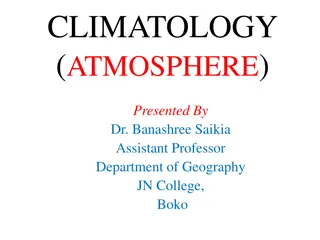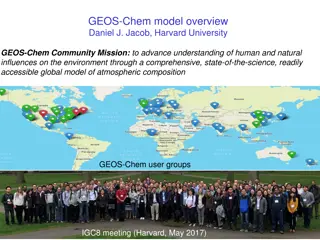Analysis of Atmospheric Parameters and Transmission at OHP in 2018
This analysis focuses on the atmospheric parameters and transmission at the Observatoire de Haute-Provence (OHP) during 2018, with a specific emphasis on distinguishing between typical winter and summer conditions. The study utilizes MERRA2 data from January to August to examine pressure, precipitable water vapor, ozone levels, aerosols optical depth, Angstrom coefficient, and average transmission for both seasons. LibRadTran simulations are conducted to generate profiles for Stardice analysis at various air masses. The findings provide valuable insights into the atmospheric characteristics at OHP, essential for astronomical observations and research.
Download Presentation

Please find below an Image/Link to download the presentation.
The content on the website is provided AS IS for your information and personal use only. It may not be sold, licensed, or shared on other websites without obtaining consent from the author.If you encounter any issues during the download, it is possible that the publisher has removed the file from their server.
You are allowed to download the files provided on this website for personal or commercial use, subject to the condition that they are used lawfully. All files are the property of their respective owners.
The content on the website is provided AS IS for your information and personal use only. It may not be sold, licensed, or shared on other websites without obtaining consent from the author.
E N D
Presentation Transcript
Atmosphere parameters and Atmosphere Transmission at OHP in 2018 : application to Stardice analysis Sylvie Dagoret-Campagne LAL LSST-France, APC LSST-France, November 2018 1
Goal Provide typical OHP atmospheric transmission Distinguish typical winter/summer Need to collect relevant atmospheric parameters Use MERRA2 data in 2018 (January-August) LSST-France, November 2018 2
Pressure Winter Summer Summer Winter P = 939 hPa P = 933 hPa Higher pressure In summer LSST-France, November 2018 3
Precipitable water vapor Winter Summer Winter Summer PWV = 10mm PWV = 25mm Higher PWV in summer LSST-France, November 2018 4
Ozone Winter Summer Summer Winter O3 = 318 DbU O3 = 370 DbU Higher Ozone in winter LSST-France, November 2018 5
Aerosols optical depth Winter Summer Winter Summer tau0 = 0.10 tau0 = 0.16 0 Higher in summer LSST-France, November 2018 6
Angstrom coefficient Winter Summer Winter Summer a a = 1.14 a = 1.25 Steeper Wavelength Attenuation in summer LSST-France, November 2018 7
Average transmission Summer & Winter Airmass = 1 Transmission calculated by LibRadTran simulation LSST-France, November 2018 8
Average Transmission Winter/Summer ratio Airmass = 1 Pressure (Rayleigh) 0.5% Ozone Chappuis 0.6% Ozone Huggins cutoff PWV LSST-France, November 2018 9
Winter/Summer Libradtran Profiles generated for Stardice analysis at several airmass Summer Simulations Required for Data analysis Winter LSST-France, November 2018 10
Winter/Summer Libradtran transmission ratio generated for Stardice analysis at several airmass LSST-France, November 2018 11
Zoom on Winter/Summer Profiles ratio generated for Stardice analysis at several airmass Pressure (Rayleigh) 1.25% Ozone Chappuis 1.25% Ozone Huggins cutoff PWV LSST-France, November 2018 12
Analytical model for Molecular scattering Analytic model : altitude vs pressure : Airmass=1 OHP Altitude 650m Molecular transparency profiles Libradtran : absorption switched off Airmass=1 Ratio Molecular transparency profiles : Libradtran/analytical model Summer : h~636 m Winter : h~690 m 1%@(300nm) LSST-France, November 2018 13
Winter 1%(am=1)-2%(am=2.5) @(300nm) Libradtran/analytic al-formula transparency ratio at all airmass Summer 1%(am=1)-2%(am=2.5) @(300nm) LSST-France, November 2018 14
1%(am=1)-2%(am=2.5) @(300nm) Winter/Summer transparency ratio at all airmass Winter/Summer transparency ratio Conclusion: Better use analytical formula to correct profile for Pressure variation <0.5% @(300nm) Winter/Summer transparency ratio normalized to Analytical transparency ratio LSST-France, November 2018 15
Take home message Typical winter/summer atmospheric profiles at various airmass are provided for Stardice. Average pressure, precipitable water vapor,ozone. Simulated transparency data A numerical-analytical formula for atmospheric transparency to correct for daily pressure variation (auxiliary data) lead to an accuracy better than 0.5% for >300 nm LSST-France, November 2018 16























